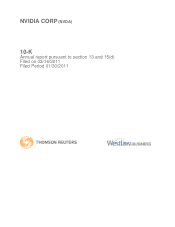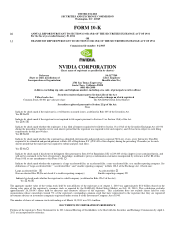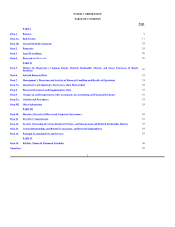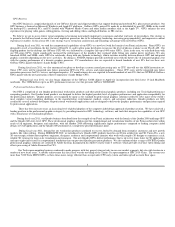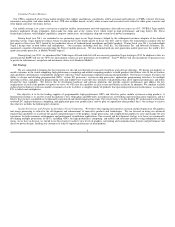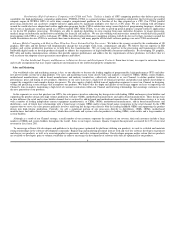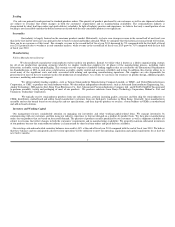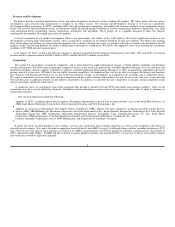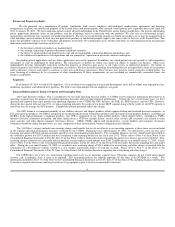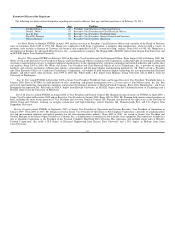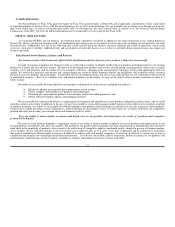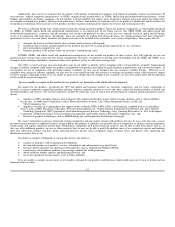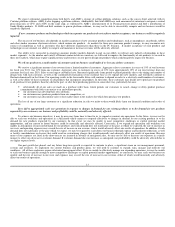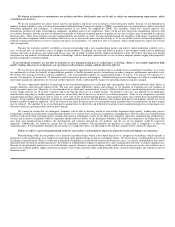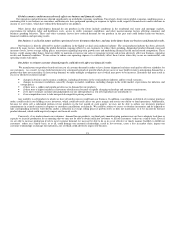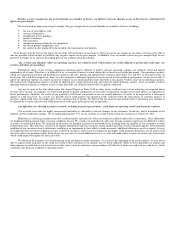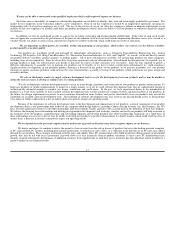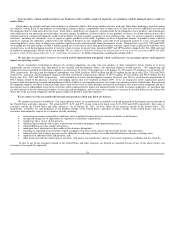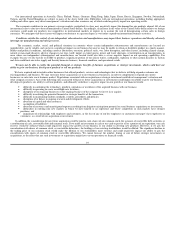NVIDIA 2011 Annual Report Download - page 11
Download and view the complete annual report
Please find page 11 of the 2011 NVIDIA annual report below. You can navigate through the pages in the report by either clicking on the pages listed below, or by using the keyword search tool below to find specific information within the annual report.
Patents and Proprietary Rights
We rely primarily on a combination of patents, trademarks, trade secrets, employee and third-party nondisclosure agreements and licensing
arrangements to protect our intellectual property in the United States and internationally. Our currently issued patents have expiration dates from April 5th,
2011 to January 29, 2031. We have numerous patents issued, allowed and pending in the United States and in foreign jurisdictions. Our patents and pending
patent applications primarily relate to our products and the technology used in connection with our products. We also rely on international treaties,
organizations and foreign laws to protect our intellectual property. The laws of certain foreign countries in which our products are or may be manufactured or
sold, including various countries in Asia, may not protect our products or intellectual property rights to the same extent as the laws of the United States. This
makes the possibility of piracy of our technology and products more likely. We continuously assess whether and where to seek formal protection for particular
innovations and technologies based on such factors as:
• the location in which our products are manufactured;
• our strategic technology or product directions in different countries;
• the degree to which intellectual property laws exist and are meaningfully enforced in different jurisdictions; and
• the commercial significance of our operations and our competitors’ operations in particular countries and regions.
Our pending patent applications and any future applications may not be approved. In addition, any issued patents may not provide us with competitive
advantages or may be challenged by third parties. The enforcement of patents by others may harm our ability to conduct our business. Others may
independently develop substantially equivalent intellectual property or otherwise gain access to our trade secrets or intellectual property. Our failure to
effectively protect our intellectual property could harm our business. We have licensed technology from third parties for incorporation in some of our products
and for defensive reasons, and expect to continue to enter into such license agreements. These licenses may result in royalty payments to third parties, the
cross licensing of technology by us or payment of other consideration. If these arrangements are not concluded on commercially reasonable terms, our
business could suffer.
Employees
As of January 30, 2011 we had 6,029 employees, 4,161 of whom were engaged in research and development and 1,868 of whom were engaged in sales,
marketing, operations and administrative positions. We believe our relationships with our employees are good.
Financial Information by Business Segment and Geographic Data
Our Chief Executive Officer, who is considered to be our chief operating decision maker, or CODM, reviews financial information presented on an
operating segment basis for purposes of making operating decisions and assessing financial performance. During the last several fiscal years, we have
operated and reported four major product-line operating segments to our CODM: the GPU business, the PSB, the MCP business, and the CPB. However,
during the first quarter of fiscal year 2011, we began reporting internally the results of our former MCP segment along with the results of our GPU segment to
reflect the way we manage the GPU business. Comparative periods presented reflect this change.
Our GPU business is comprised primarily of our GeForce discrete and chipset products which support desktop and notebook personal computers, or
PCs, plus memory products. Our PSB is comprised of our Quadro professional workstation products and other professional graphics products, including our
NVIDIA Tesla high-performance computing products. Our CPB is comprised of our Tegra mobile products which support tablets, smartphones, PMPs,
internet television, automotive navigation, and other similar devices. CPB also includes license, royalty, other revenue and associated costs related to video
game consoles and other digital consumer electronics devices. OEMs, ODMs, add-in-card manufacturers, system builders and consumer electronics
companies worldwide utilize our processors as a core component of their entertainment, business and professional solutions.
The “All Other” category includes non-recurring charges and benefits that we do not allocate to our operating segments as these items are not included
in the segment operating performance measures evaluated by our CODM. During the year ended January 30, 2011, we entered into a new six-year cross
licensing agreement with Intel and also mutually agreed to settle all outstanding legal disputes. For accounting purposes, the fair valued benefit prescribed to
the settlement portion was $57.0 million and was considered a non-recurring benefit for the fiscal year 2011. Please refer to Note 4 of these Notes to the
Consolidated Financial Statements in Part IV, Item 15 of this Form 10-K for further discussion regarding the patent cross license agreement with Intel. Non-
recurring charges related to our cash tender offer to purchase certain employee stock options were $140.2 million for the year ended January 31, 2010. Please
refer to Note 2 of the Notes to the Consolidated Financial Statements in Part IV, Item 15 of this Form 10-K for further discussion regarding the cash tender
offer. During the year ended January 25, 2009, we recorded a non- recurring charge of $26.9 million for restructuring and other charges associated with the
termination of a development contract related to a new campus construction project we had put on hold. Please refer to Note 6 of the Notes to the
Consolidated Financial Statements in Part IV, Item 15 of this Form 10-K for further discussion regarding the restructuring and other charges.
Our CODM does not review any information regarding total assets on an operating segment basis. Operating segments do not record intersegment
revenue, and, accordingly, there is none to be reported. The accounting policies for segment reporting are the same as for NVIDIA as a whole. The
information included in Note 17 of the Notes to the Consolidated Financial Statements in Part IV, Item 15 of this Form 10-K, including financial information
by business segment and revenue and long-lived assets by geographic region, is hereby incorporated by reference.
9

